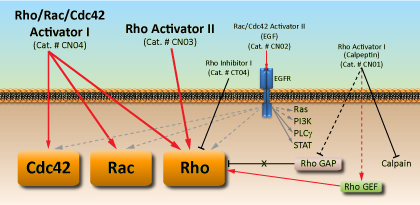
Introduction
The G-switch™ line of small G-protein tools has been developed with an emphasis on creating highly potent reagents that target endogenous Rho family proteins and pathways. In contrast to methods that rely on over-expression or knockdown of target proteins (e.g., DNA transfection of dominant-negative or constitutively-active Rho mutants, RNAi knockdown), G-switch™ reagents act rapidly on the endogenous target protein (in minutes to hours, depending on the product), thereby optimizing the chance of generating a more physiologically relevant response. The G-switch™ product line includes reagents that directly and indirectly modulate Rho family signal transduction, thereby offering a wide range of mechanistic tools to study these critical cellular functions. See Cytoskeleton's web site for the latest G-switch™ information.

Product Uses Include
- Rho pathway studies in tissue culture cells
- Study effects of altered Rho pathway on other connected pathways
- An active control when testing other substances
| Product | Description | Manual | MSDS | Price & Order |
Rho Activator II | Cell permeable, specific for Rho, recommended for use in Rho pathway studies requiring a direct activator of Rho | CN03 | ||
Rho Inhibitor I | Cell permeable C3 transferase, specific for Rho, inhibits cellular Rho within 2-4h, recommended for use in Rho pathway studies requiring a rapid and direct inhibitor of Rho | CT04 | ||
Rho/Rac/Cdc42 Activator I | Cell permeable, specific for Rho family, recommended for use in Rho pathway studies requiring a direct activator of Rho family proteins | CN04 | ||
Rho Activator I | Inhibits SHP-2 which indirectly activates Rho, recommended for use in Rho pathway studies requiring an indirect activator of Rho | CN01 | ||
Rac/Cdc42 Activator II | Binds EGF receptor and activates several pathways, including indirect activation of Rho family proteins, recommended for use in Rho pathway studies requiring an indirect activator of Rac/Cdc42 | CN02 | ||
| C3 Transferase Protein | Non-cell permeable C3 transferase, this product is taken up by cells through pinocytosis over 12-24h, specific for Rho, recommended for use in Rho pathway studies requiring a direct inhibitor of Rho that acts over a longer time period than the cell permeable version of this enzyme. | CT03 |
Specification of Activators:
Activator | Advantage | Disadvantages | Window of activation | Serum compatible |
G-switch™ Type: Direct
| The most robust activator for Rho available Sustained activation of Rho GTPases for >2hr Eliminates Ras, PI3K and PLC concomitant activation Most suitable activator for studying specific signal transduction pathways downstream of the Rho GTPases | Cannot be used to study GAPs C3 exoenzyme (Cat# CT04) will not inhibit CN03 activated small G-proteins | 2 - 12 h, no signal after 24 h*. | YES |
G-switch™ Type: Direct, | The most robust activator for Rac and Cdc42 available, second only to CN03 for Rho activation Sustained activation of Rho, Rac and Cdc42 for >2hr Eliminates Ras, PI3K and PLC concomitant activation Excellent activator for studying signal transduction pathways downstream of Rho, Rac and Cdc42 | Cannot be used to study GAPs C3 exoenzyme (Cat# CT04) will not inhibit CN04 activated small G-proteins | Rho; 2 - 12 h, no signal after 24 h*. Rac; 2 - 24 h, no signal after 48 h. Cdc42; 2 - 24 h, no signal after 48 h. | YES |
Rac/Cdc42 Activator Type: Indirect, | Physiological stimulus Useful in studying pathway between cell surface and small G-proteins | Very transient activation Ras, PI3K and PLC also activated | 1 - 3 min, no signal after 5 min. | YES |
Rho Activator I Type: Indirect | More sustained Rho activation than EGF (Cat# CN02) Eliminates Ras, PI3K and PLC concomitant activation | Also inhibits calpain Inhibition of SHP-2 may have other biological consequences Requires DMSO vehicle | 10 - 30 min, no signal after 120 min. | YES |
* variable signal after 24h (1) References 1. Boyer L, Turchi L, Desnues B, Doye A, Ponzio G, Mege JL, Yamashita M, Zhang YE, Bertoglio J, Flatau G, Boquet P, Lemichez E. CNF1-induced ubiquitylation and proteasome destruction of activated RhoA is impaired in Smurf1-/- cells. Mol Biol Cell. 2006 Jun;17(6):2489-97 | ||||
